Biopharmaceutical companies and their partners are taking a page from Silicon Valley by sponsoring hackathons and competitions to drive innovation in research and develop new solutions for patients.
Pharma companies are reaching outside their own walls to discover innovative new ways to improve the R&D process. And they are employing some of the same methods as tech companies to find and fund transformation: hackathons and innovation contests.
In this context, hacking means coming up with rapid, clever, and unexpected solutions. Hackathons provide an opportunity for creative thinking and access to ideas and expertise. These design contests allow for partnerships with academia, entrepreneurs, companies — really, anyone who wants to help solve problems in healthcare.
A number of pharmaceutical companies — large and small — have developed competition programs to encourage the development of new technologies and bring new expertise to the table. Astellas, LEO Pharma, Johnson & 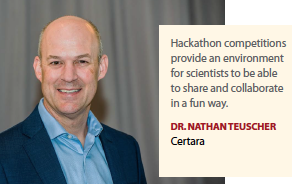 Johnson, Mylan, Novo Nordisk, and Sandoz are just a few of the companies that have developed hackathon programs to bring together a variety of specialists to work intensively on solving particular problems.
Johnson, Mylan, Novo Nordisk, and Sandoz are just a few of the companies that have developed hackathon programs to bring together a variety of specialists to work intensively on solving particular problems.
“We all recognize innovation is occurring everywhere," says Erika Kula, director, sourcing innovation, JLABS. “Companies can’t operate within their specific silos and expect to be able to identify the top technologies available. Companies have to communicate with entrepreneurs and innovators, and one way to excite the community is through crowd-sourced innovation."
McKinsey analysts say successful hackathons deliberately challenge participants to reimagine an idealized method for addressing a given customer need. The goal is to toss aside traditional notions of how things are done and reimagine the richest, most efficient way to improve the technology, service, or product.
“Hackathons, crowdsourcing, and open innovation are different models to access external competencies that a company may not have access to 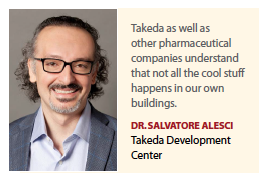 internally," says Niclas Nilsson, Ph.D., head of LEO Open Innovation. “Companies are starting to realize they need to open themselves up for external input to solve problems using cutting-edge technologies."
internally," says Niclas Nilsson, Ph.D., head of LEO Open Innovation. “Companies are starting to realize they need to open themselves up for external input to solve problems using cutting-edge technologies."
Life-science companies are using open innovation to solve a variety of problems, from helping to find potential new targets, to developing new patient solutions, to developing new digital technologies.
“We believe engaging in crowd-sourcing, we are much more part of the healthcare ecosystem; we recognize drugs are not developed in isolation by companies, but more and more through partnerships," says Salvatore Alesci, M.D., Ph.D., VP and head of R&D global patient and scientific affairs, Takeda Development Center Americas. “We believe that we have a duty as a corporate citizen to contribute to the scientific community. Through award and grant competitions and other similar initiatives, companies can help promote and advance scientific learning to the benefit of the patients. Takeda and other pharmaceutical companies are engaging more and more with those outside of our own sector (i.e., pharma industry collaborating with academia, digital companies, nonprofit organization.) We understand that not all the cool stuff happens in our buildings."
Health hackathons have grown exponentially over the past decade, 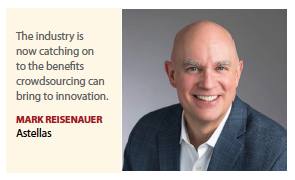 according to the MIT Hacking Medicine Health Hackathon Database. In 2010, MIT’s Hacking Medicine was the first such reported event in healthcare. In MIT’s database of more than 100 health hackathons, the average health hackathon engages about 170 participants and has an average prize package of $12,000. Overall, about $500,000 has been awarded through the hackathons in MIT’s database.
according to the MIT Hacking Medicine Health Hackathon Database. In 2010, MIT’s Hacking Medicine was the first such reported event in healthcare. In MIT’s database of more than 100 health hackathons, the average health hackathon engages about 170 participants and has an average prize package of $12,000. Overall, about $500,000 has been awarded through the hackathons in MIT’s database.
Health hackathons span the globe as well as the entire healthcare spectrum, according to MIT. Almost every type of stakeholder in healthcare — pharma, nonprofit, hospitals, tech companies, academia, the government, and providers — has used a hackathon to address an unmet need. Solutions have ranged from apps, to wearables, to hardware, and other solutions.
Some contests have stemmed from the personal experiences of people working in the healthcare space.
Take, for example, the Astellas Oncology C3 (Changing Cancer Care) Prize. For Mark Reisenauer, senior VP of the oncology business unit at Astellas, it was caring for his father, who had head and neck cancer, that led to the development of the Astellas Oncology C3 Prize.
“I’ve been in oncology for a long time, and I thought I had a pretty good handle on a lot of aspects of cancer care," he says. “I’ve done a lot of work with patient organizations and thought I had a reasonable understanding of 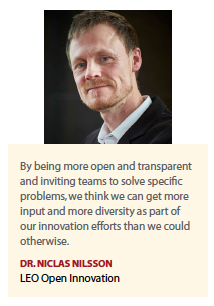 what patients go through as well as their caregivers. I couldn’t have been more wrong."
what patients go through as well as their caregivers. I couldn’t have been more wrong."
He says the biggest issues for patients as they go through treatment is not the treatment itself, but everything else related to the care, including getting to the doctor’s office or the hospital or navigating the insurance and payer issues.
“I was sharing my experiences with our internal team and we agreed there had to be a better way to address some of these big issues," he says. “This is when we came upon the idea of holding an innovation contest to focus on some of the biggest problem areas: navigation, survivorship, and education. Through this innovation contest, we knew we would see better ideas than we could ever come up with ourselves."
The Astellas Oncology C3 Prize has done three challenges so far. In its third year, entrants were challenged to come up with solutions that transform cancer care in low- and middle- income countries, whose populations bear a disproportionate burden of the global cancer epidemic. The company received more than 80 submissions from across the globe, and judges chose five semi-finalists, who participated in a live pitch session.
In October 2018, Ebele Mbanugo from Lagos, Nigeria, won the Grand Prize for her Run For a Cure Africa Breast Cancer Foundation. She received a $50,000 grant and mentoring to help bring her winning idea to transform cancer care to life. The other two winners received $25,000 grants.
Ms. Mbanugo’s idea is to produce a culturally relevant and easy-to-understand digital audio series — the first of its kind — that addresses common myths and barriers to breast cancer treatment in Nigeria. With the 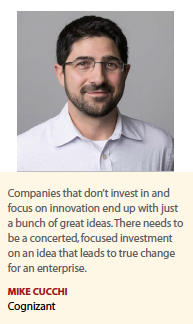 grant money from the C3 Prize, she will bring together local actors and writers in-studio to create a pilot project that tests her prize-winning theory that the Nigerian penchant for good stories will make this entertaining and educational series a success.
grant money from the C3 Prize, she will bring together local actors and writers in-studio to create a pilot project that tests her prize-winning theory that the Nigerian penchant for good stories will make this entertaining and educational series a success.
“We have created a mission and a vision that we believe is important," Mr. Reisenauer says. “Our vision is to be highly valued for providing effective solutions that really enable cancer patients to focus on living. Those of us in oncology understand that it’s not just about providing therapies; it’s a broader commitment that we have to patients living with cancer and supporting the physicians and other healthcare professionals who treat them."
Mr. Reisenauer says making programs like Run for a Cure a success involves aligning the criteria with what is actually happening in the real world and with the needs of patients and their issues in the marketplace.
Astellas is in the planning stages for its next C3 Prize. Mr. Reisenauer says the format will be similar to previous years with a live pitch session and the program will continue to look for ideas to improve cancer care that are non-treatment related.
Another company having success with innovation contests is Johnson & Johnson. Johnson & Johnson Innovation – JLABS (JLABS) has initiated more than 30 QuickFire Challenges, which aim to seek out the best science 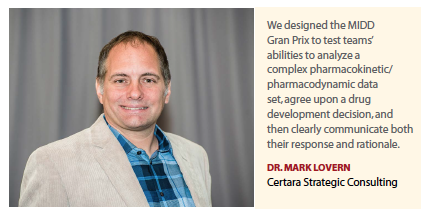 in a no-strings attached model. The QuickFire Challenges offer cash grants, mentoring, and access to the JLABS global ecosystem.
in a no-strings attached model. The QuickFire Challenges offer cash grants, mentoring, and access to the JLABS global ecosystem.
“Part of Johnson & Johnson Innovation’s mantra is that innovation can happen anywhere," Ms. Kula says. “Innovation doesn’t have to be clustered in one of our hubs around the globe. We want to inspire innovators who are working in ecosystems outside of those hubs."
She says the company wants to harness crowdsourcing and the innovation ecosystem to inspire innovators to be creative, to think differently about their technologies, and to look at these contests as an opportunity to partner with J&J.
Ms. Kula says the QuickFire Challenges are structured differently from a traditional hackathon. Rather, the company asks participants to submit an application and, when the application period closes, a panel of judges reviews and identifies top applicants to bring forward as finalists. Each challenge has different criteria, and judges look for quality solutions, the disruptive nature of the solution, and whether there is market appeal.
JLABS announced in January the winner of its First 1,000 Days QuickFire Challenge. This challenge aimed to find technologies that address the first 1,000 days of life, which includes maternal health all the way through to the second birthday of the child. A $250,000 award was given to Bloomlife, which developed a technology that monitors real-time uterine activity for contraction frequency, duration, patterns, and trends.
JLABS recently closed two challenges. The first is the Nurses Innovate QuickFire Challenge, which empowers nurses as innovators. The company invited nurses in the United States to submit ideas for new devices, health technologies, protocols, or treatment approaches. The company has committed up to $100,000 in grants and access to mentoring and coaching.
The other challenge is the Reimagining Respiratory Protection QuickFire Challenge, in collaboration with the Biomedical Advanced Research and Development Authority (BARDA), a component of the Office of the Assistant Secretary for Preparedness and Response in the U.S. Department of Health and Human Services. The challenge is seeking innovative devices that have the potential to protect against respiratory infection outbreaks. Two winners will be awarded up to $100,000 in grant funding.
“Each challenge is unique," Ms. Kula says. “Each challenge needs to have its own custom framework, a custom call to action, a custom messaging strategy, and its own network of people to be tapped. When we do global challenges, messaging that resonates in the United States might resonate differently in other countries. We need to think through how to communicate with entrepreneurs around the globe in terms of the technology areas that are of interest, what excites them, and how to get them thinking about their solutions. This takes a lot of time, effort, and attention to detail."
Competitions for Drug Targets
As the industry continues to address the challenges of how to find, access, and nurture innovation in drug discovery, some companies are turning to hackathons to help find potential new targets for drug development.
“We are a medium-size pharmaceutical company and we rely on external expertise," LEO Pharma’s Dr. Nilsson says. “We needed a way to reach out differently, with greater frequency, and more efficiently to engage with others than we have done in the past."
LEO has three new initiatives ongoing to access innovations. These include an open innovation platform, which opens up Leo Pharma’s research to external partners; with the Boston Science & Tech Hub, which focuses on achieving access to cutting-edge technology; and an innovation lab, which focuses on nonprescription-based solutions for patients.
Dr. Nilsson says LEO has engaged in hackathons for both the Boston Tech Hub and the open innovation platform. “By being more open and transparent and inviting teams to solve specific problems, we think we can get more input and more diversity in our innovations than we would if we just did it ourselves," he says.
The most recent hackathon was conducted by LEO’s Boston Science & Tech Hub, along with MIT’s Hacking Medicine Institute (HMi) and Advancing Innovation in Dermatology (AID). In April 2018, the companies gathered about 40 specialists in dermatology — practitioners, patients, and researchers — to figure out what are the main challenges for patients living with skin diseases. From this meeting, five questions emerged that would be presented at the Hacking Dermatology Hackathon, which was held over three days in June 2018.
The hackathon engaged 120 participants broken down into 20 teams; the participants spent three days learning about the challenges and developing solutions to address them. At the end of the hackathon, five teams were awarded $5,000 each to enter a condensed incubation period. In October, these teams went before a panel of expert judges to compete for $55,000 in grants.
“The goal was to produce a solution to one of the five questions that can be pursued," Dr. Nilsson says. “The ideas came from a real understanding of real patient problems identified by the whole community and solved from a multidisciplinary perspective."
The first place team, Lucid, focused on an at-home patch testing for targeted allergies. Other winning teams included RxThat, an online prescription marketplace and management application, and MatchLab, a skin-image analysis service that provides image tracking and datasets for use in AI diagnostic models.
Another LEO hackathon occurred in early 2018, which aimed to use AI in order to identify new drug targets to treat eczema.
“There is simply a lack of good drug targets for eczema," Dr. Nilsson says. “The challenge that we face in research is finding new drug targets that we can explore. We wanted to find a new drug target and to see if we could apply a new technology."
LEO teamed up with the AI company, iris, that does text searches and text mining to find new science. Five teams over two days used the AI tools to mine 80 million articles from the scientific literature to find new drug targets for eczema.
The winning team received 5,000 euros as a reward for identifying a novel target opportunity.
“This was a very specific hackathon that combined drug research competence with computer science, programming, and AI, and the people who showed up had a specific passion for this technology," Dr. Nilsson says. “With this hackathon, we wanted to engage people with competencies who we normally wouldn’t work with — entrepreneurs, students, and other people who we don’t usually see in the traditional pharma research setting. It’s important for us to access this community of science that is slightly different from what we do ourselves. This has been an important learning for us."
Dr. Nilsson says for participants there is an opportunity to have an impact on something real. “This is really important," he says. “For us, we get to think outside our own boxes."
Competitions for Patient Solutions
Novo Nordisk, for the first time, sponsored their own digital health innovation challenge last year.
“We have a rich history focusing on diabetes, medication, and device innovation, and we want to continue to advance our offerings and the value and the benefits that we deliver," says Amy West, senior director, patient centric marketing & digital health innovation, Novo Nordisk. “But we can’t necessarily do it alone. There’s a lot happening in the technology space and digital health. We believe there are many experts who we might be able to partner with to bring innovative solutions to the table."
Novo Nordisk, she says, wanted to challenge entrepreneurs and academics to bring their ideas for potential solutions to people who have diabetes.
“This was an effort to cast a broader net to the start-up community, to establish relationships, and potentially start to build those solutions out," Ms. West says.
The company received 73 submissions from around the world for the Novo Nordisk Innovation Challenge. The challenge called on innovators to develop ways to use data generated by Novo Nordisk’s marketed pen injectors to improve the care of, and quality of life for, people currently living with diabetes.
Twelve semi-finalists were selected to attend an innovation boot camp in November hosted by MATTER, a collaborative that includes more than 200 cutting-edge start-up companies from around the world, working together with hospitals and health systems, universities, and industry-leading companies to build the future of healthcare. At boot camp, the semi-finalists had the opportunity to further refine their concepts in advance of the pitch event.
In December 2018, five finalists were each awarded $25,000, a one-year membership with the MATTER community, and the opportunity to further nurture their solution with Novo Nordisk, beginning with an intensive, semi-virtual accelerator program developed by MATTER.
The finalists included Adelie Health, HumanCapitalWorks, Medopad, SimpleC, and xBird.
Adelie Health developed a replacement pen cap that fits on to all prefilled insulin pens. The cap includes reminders and alarms, a sensor to detect usage, and Bluetooth to send data to a smart device.
HumanCapitalWorks proposed Emmett, a digital health solution for parents and caregivers of patients with Type 1 diabetes that combines continuous streams of data from IoT devices with a voice-enabled interface to reduce the cognitive burden, anxiety, and fear associated with the critical decisions made during management of the disease.
Medopad offers a remote monitoring solution with modular functionality that provides clinicians, caregivers, and patients continuous visibility to enable earlier detection of health problems and create the opportunity for clinicians to engage with patients to support and achieve optimal glycemic control.
SimpleC is a platform powered by AI to deliver ongoing, individualized, evidence-based digital therapeutics for seniors living with varying states of cognitive impairment and diabetes. Their solution is designed to help maintain adherence to a patient’s care plan, as well as incorporate provider and caregiver involvement.
xBird employs machine learning algorithms to analyze micro-movements and other data collected by sensors built into people’s smartphones and wearables. The technology creates a journey map of a person’s day, highlighting those activities that happened in the context of hypo- and hyperglycemic events.
“We have more than 50 mentors across Novo Nordisk committing time to this challenge and to our finalists to help them as they further advance their offerings," Ms. West says. “This speaks volumes to the commitment of the organization, which is one of the keys to making the competition and the partnership sustainable."
Another key to a successful competition is clearly setting up the challenge or the problem to be solved so that the right type of submissions are received to meet the needs of the company as well as its customers.
Competitions for New Tech Solutions
Pharmaceutical partners are also looking to competitions as a way to access both internal and external expertise.
For example, Cognizant is using innovation competitions to spark new ideas internally. Cognizant’s LaunchPad Challenges are six-month, twice-yearly programs that create internal start-ups and well-crafted products through a structured process.
The ideas address a wide range of challenges and opportunities, from process improvements with revenue impact — such as transforming clinical trial protocol authoring with a collaborative digital platform — to ideas that look at value creation in a completely new way. The company’s first cohort of start-ups is building solutions in life-sciences and insurance, representing a total addressable market of more than $1 billion.
The company has had four events. With an average of 400 to 600 submissions per LaunchPad challenge, Accelerator has pursued close to 30 ideas, nine of which are either launched as products or slated for general availability. The LaunchPad concept is similar to Shark Tank, says Mike Cucchi, VP in the Cognizant Accelerator unit.
“LaunchPad is the process of culling through the hundreds of concepts to identify the top 10 most relevant, most impactful, and most aligned ideas," he says. “We identify a start-up leader for those selected ideas, and then we spend six months vetting those ideas in the market with our clients and within the industry. For these ideas, we will build business plans, conduct market validation studies, and develop investment profiles that we then present to the Cognizant executive team during Pitch Day."
Mr. Cucchi says the company funds about half of the ideas that are presented. So far, nine products have come out of these challenges and two have already been launched — both in the life-sciences industry.
He says successful programs are more than hackathons; there has to be a commitment to investing in programs that advance innovation.
“One of the lessons we learned is to stay true to the cause and to what we are trying to achieve, and at the end of the day we have access to an amazing group of people with great ideas," he says.
Competitions for Researchers
Supporting grant competitions that focus on recognizing research accomplishments are an area of focus for companies in the life science.
One such company is Takeda Pharmaceutical Company. In December 2018, Takeda and the New York Academy of Sciences announced the winners of the second annual Innovators in Science Award for their commitment to and excellence in regenerative medicine. Takeda’s first innovation award in 2017 focused on neuroscience.
The Innovators in Science Award grants two prizes of $200,000 each year: one to an early-career scientist and the other to a well-established senior scientist who have distinguished themselves for their creative thinking and the impact of their research.
“The main goal for this award was to recognize and foster careers of scientists working in areas of focus for our R&D organization," Dr. Alesci says.
The 2019 winner of the Senior Scientist Award is Michele De Luca, M.D., professor of biochemistry and director of the Centre for Regenerative Medicine. Dr. De Luca has dedicated his career in translational medicine to developing stem cell therapies and is a leading authority on human squamous epithelial stem cell biology.
The 2019 winner of the Early-Career Scientist Award is Shruti Naik, Ph.D., assistant professor, departments of pathology, medicine and dermatology, NYU School of Medicine. Dr. Naik studies immune cell, epithelial cell, and microbial interactions to inform therapeutic strategies for conditions such as psoriasis, chronic wounds, and cancer.
Some competitions aim to help researchers gain skills. For example, last year, Certara partnered with faculty at the UNC Eshelman School of Pharmacy to launch the Model-Informed Drug Development (MIDD) Gran Prix at the 2018 American Society for Clinical Pharmacology & Therapeutics Annual Meeting.
The MIDD Gran Prix was designed to test teams’ abilities to analyze a complex pharmacokinetic/pharmacodynamic data set, agree upon a drug development decision, and then clearly communicate both their response and rationale. The teams were tasked with formulating a drug development decision, supported by their data analysis, and submitting it for peer review.
Participating teams were granted access to pharmacokinetic/pharmacodynamic data from three simulated clinical trials on Oct. 31, 2017. They were asked to develop dosing guidelines for “Drug D," including individual dosing strategies where appropriate.
They also needed to decide whether to conduct another Phase II or a Phase III study next. The best two professional and two student teams competed in the finals at the 2018 American Society for Clinical Pharmacology & Therapeutics (ASCPT) annual meeting in March.
The competition was a way to boost the communication skills of those who work in pharmacometrics, says Nathan Teuscher, Ph.D., VP, integrated drug development at Certara Strategic Consulting.
“We wanted to have an opportunity for people to hone or improve their communication skills and be rewarded," he says. “The competition was less about how to do the actual technical analysis, and more about how to communicate their findings. The teams that were successful were the ones who were more effective at communications."
Mark Lovern, Ph.D., VP, integrated drug development at Certara Strategic Consulting, says there is a need to teach people in the industry to be better communicators.
“Our competition is one way of facilitating this goal, but I think there’s a lot more that can be done," he says. “I have been conducting a straw poll among senior members of our discipline, including CEOs of competitor consultancy firms, and across the board they say the difficulty in finding staff is not about finding people who can analyze data, but finding people who can actually craft a story around the results. Communication comes up again and again as a limiting factor."(PV)
~~~~~~~~~~~~~~~~~~~~~~~~~
MIT Hacking Medicine
Hackathons are a uniquely powerful mechanism for industry-wide experimentation and collaboration. In the spirit of cross-sector sharing and cooperation, MIT has developed a global health hackathon database to provide insight from the crowd, provide access to the latest solutions, offer an overview of trends, and encourage new connections among participants and sponsors. This database is open and free and contributions to this living log of groups working together to solve real-world problems in healthcare is welcome. For more information, visit http://hackingmedicine.mit.edu.
A living, downloadable database of more than 100 health hackathons
A hackathon is a 24-48 hour event where people get together to solve a specific problem with like-minded individuals.
Hackathons are attended by: mentors, designers, developers, patients, health professionals, and entrepreneurs.
Source: MIT Hacking Medicine
~~~~~~~~~~~~~~~~~~~~~~~~~
Why Put on a Hackathon?
Tinker, build, and experiment in a safe zone
Democratization of innovation — anyone, including patients can get involved
Platform for collaboration across boundaries and silos
Accelerated, creative problem solving that leads to action
Learn new skills, have fun, build a community
Source: MIT Source: MIT Hacking Medicine

















